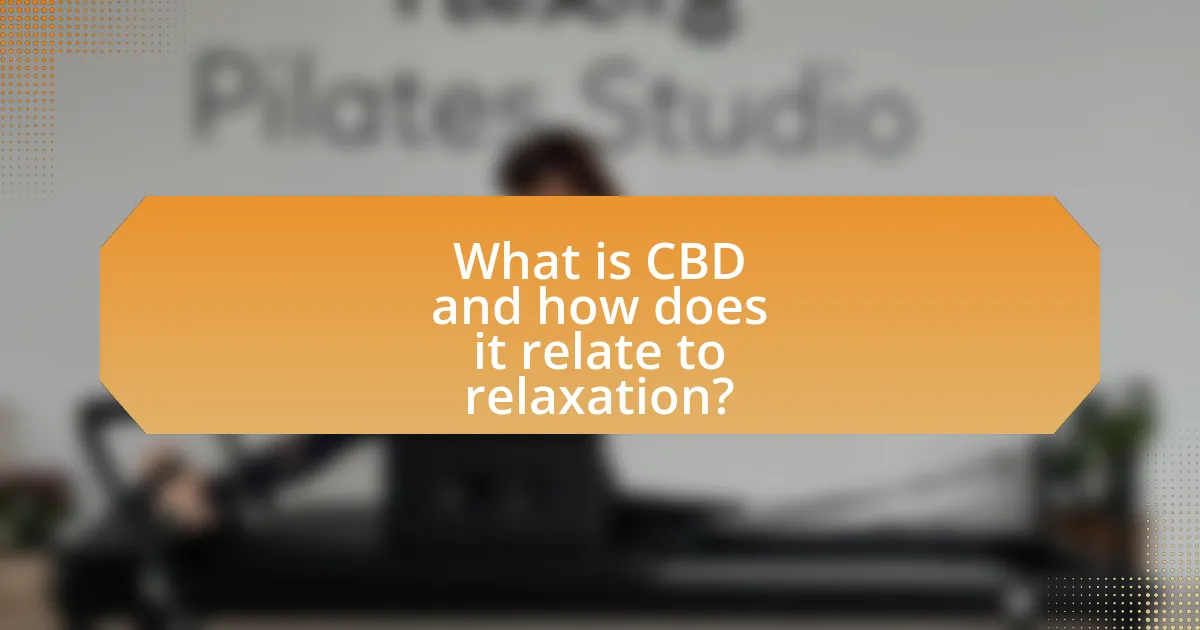CBD, or cannabidiol, is a compound derived from the cannabis plant that is recognized for its potential to promote relaxation and alleviate anxiety. The article explores how CBD interacts with the body’s endocannabinoid system, influencing neurotransmitters and contributing to a sense of calm. It discusses various forms of CBD available for relaxation, such as oils, edibles, and topicals, and highlights best practices for incorporating CBD into a self-care routine at home. Additionally, the article emphasizes the importance of creating a tranquil environment through elements like lighting, color schemes, and furniture arrangement to enhance the overall relaxation experience.

What is CBD and how does it relate to relaxation?
CBD, or cannabidiol, is a compound derived from the cannabis plant known for its potential therapeutic effects, including promoting relaxation. Research indicates that CBD interacts with the endocannabinoid system in the body, which plays a crucial role in regulating mood, stress, and anxiety levels. A study published in the journal Neurotherapeutics found that CBD may reduce anxiety and improve sleep quality, both of which are essential for relaxation. This evidence supports the idea that CBD can be an effective aid in creating a calm and soothing environment, contributing to overall relaxation.
How does CBD interact with the body to promote relaxation?
CBD interacts with the body primarily through the endocannabinoid system (ECS), which plays a crucial role in regulating mood, stress, and relaxation. When CBD is consumed, it binds to cannabinoid receptors in the ECS, particularly the CB1 and CB2 receptors, influencing neurotransmitter release and promoting a sense of calm. Research indicates that CBD can reduce anxiety and improve sleep quality, both of which are essential for relaxation. A study published in the Journal of Psychopharmacology found that CBD significantly decreased anxiety in participants, supporting its role in promoting relaxation.
What are the key components of the endocannabinoid system involved in relaxation?
The key components of the endocannabinoid system involved in relaxation are endocannabinoids, cannabinoid receptors, and enzymes. Endocannabinoids, such as anandamide and 2-arachidonoylglycerol, are naturally occurring compounds that bind to cannabinoid receptors in the body. The primary receptors, CB1 and CB2, play crucial roles in modulating stress and anxiety responses. Research indicates that activation of CB1 receptors in the brain can lead to reduced anxiety and enhanced feelings of relaxation. Enzymes, such as fatty acid amide hydrolase, are responsible for breaking down endocannabinoids, thus regulating their levels and effects on relaxation. This intricate system helps maintain homeostasis and promotes a state of calm.
How does CBD influence neurotransmitters related to stress and anxiety?
CBD influences neurotransmitters related to stress and anxiety primarily by interacting with the endocannabinoid system, which plays a crucial role in regulating mood and emotional responses. Specifically, CBD enhances the signaling of serotonin receptors, particularly the 5-HT1A receptor, which is linked to anxiety reduction and mood stabilization. Research indicates that CBD can increase serotonin levels in the brain, thereby promoting a sense of calm and reducing anxiety symptoms. A study published in the journal Neurotherapeutics by Blessing et al. (2015) supports this, showing that CBD has anxiolytic effects in both animal and human studies, highlighting its potential as a therapeutic agent for anxiety disorders.
What are the different forms of CBD available for relaxation?
The different forms of CBD available for relaxation include oils, tinctures, capsules, edibles, topicals, and vape products. CBD oils and tinctures are popular for their quick absorption and ease of use, allowing for precise dosing. Capsules provide a convenient option for those who prefer a familiar method of consumption, while edibles, such as gummies, offer a tasty way to enjoy CBD. Topicals, like creams and balms, are applied directly to the skin for localized relief, and vape products deliver CBD rapidly into the bloodstream. Each form has unique benefits, catering to various preferences and needs for relaxation.
What are the benefits of CBD oils versus edibles for relaxation?
CBD oils offer faster absorption and more immediate effects for relaxation compared to edibles. When taken sublingually, CBD oils enter the bloodstream quickly, often providing relief within 15 to 30 minutes. In contrast, edibles must be digested, which can take 1 to 2 hours for effects to manifest. Additionally, CBD oils allow for precise dosing, enabling users to adjust their intake easily based on their individual needs. This flexibility can enhance the relaxation experience by allowing users to find their optimal dosage more effectively.
How do topical CBD products contribute to a chill space at home?
Topical CBD products contribute to a chill space at home by providing localized relief from stress and tension, promoting relaxation. These products, such as creams and balms, interact with the body’s endocannabinoid system, which plays a role in regulating mood and stress responses. Research indicates that CBD can reduce anxiety and improve overall well-being, making it easier to unwind in a home environment. For example, a study published in the Journal of Psychopharmacology found that CBD significantly reduced anxiety levels in participants, supporting its use as a calming agent in personal spaces.

How can you create a chill space at home using CBD?
To create a chill space at home using CBD, incorporate CBD-infused products such as oils, edibles, or topicals into your environment. These products can promote relaxation and reduce stress, making your space more tranquil. For example, using a CBD oil diffuser can enhance the ambiance with calming scents while delivering the benefits of CBD through aromatherapy. Additionally, consuming CBD edibles, like gummies or chocolates, can help you unwind while enjoying a treat. Research indicates that CBD may help alleviate anxiety and improve mood, supporting a peaceful atmosphere in your home.
What elements should be included in a relaxing environment?
A relaxing environment should include soft lighting, comfortable seating, calming colors, natural elements, and soothing sounds. Soft lighting, such as lamps with warm bulbs or candles, creates a tranquil atmosphere. Comfortable seating, like plush sofas or bean bags, encourages relaxation. Calming colors, particularly blues and greens, have been shown to reduce stress levels. Incorporating natural elements, such as plants or water features, can enhance feelings of peace, as studies indicate that nature exposure lowers cortisol levels. Finally, soothing sounds, like gentle music or nature sounds, contribute to a serene ambiance, promoting relaxation and mental well-being.
How do lighting and color schemes affect relaxation?
Lighting and color schemes significantly influence relaxation by creating an environment that promotes calmness and comfort. Warm lighting, such as soft yellow or orange hues, has been shown to lower stress levels and enhance feelings of tranquility, while harsh, bright lighting can lead to increased anxiety and discomfort. Similarly, color psychology indicates that cool colors like blue and green are associated with serenity and can reduce heart rates, thereby fostering a more relaxed state. Research published in the Journal of Environmental Psychology supports these findings, demonstrating that environments with appropriate lighting and soothing color palettes can enhance mood and promote relaxation.
What role does furniture arrangement play in creating a chill space?
Furniture arrangement is crucial in creating a chill space as it directly influences comfort, flow, and ambiance. Properly arranged furniture promotes relaxation by ensuring that seating is inviting and conducive to conversation, while also allowing for easy movement throughout the area. For instance, placing seating in a circular formation can foster a sense of community and intimacy, which enhances the overall calming effect of the space. Additionally, strategic placement of furniture can optimize natural light and views, further contributing to a serene environment. Studies in environmental psychology indicate that spatial organization affects mood and stress levels, reinforcing the importance of thoughtful furniture arrangement in achieving a tranquil atmosphere.
How can CBD products enhance your chill space experience?
CBD products can enhance your chill space experience by promoting relaxation and reducing anxiety. Research indicates that CBD interacts with the endocannabinoid system, which plays a crucial role in regulating mood and stress levels. A study published in the Journal of Psychopharmacology found that CBD significantly reduced anxiety in participants, suggesting its potential to create a calming atmosphere in a designated relaxation area. By incorporating CBD oils, edibles, or topicals into your chill space, you can foster a more serene environment conducive to unwinding and stress relief.
What are the best CBD products to use during relaxation activities?
The best CBD products to use during relaxation activities include CBD oils, CBD gummies, and CBD-infused teas. CBD oils are effective for quick absorption and can be easily adjusted for dosage, making them ideal for achieving a calming effect. CBD gummies offer a convenient and tasty way to consume CBD, providing a consistent dose that promotes relaxation. CBD-infused teas combine the soothing properties of herbal teas with the calming effects of CBD, enhancing the overall relaxation experience. These products have been shown to reduce anxiety and improve sleep quality, supporting their effectiveness in relaxation activities.
How can you incorporate CBD into your self-care routine at home?
Incorporating CBD into your self-care routine at home can be achieved through various methods such as using CBD oils, edibles, or topical creams. For instance, applying CBD-infused topical creams can help alleviate muscle tension and promote relaxation during a bath or massage. Research indicates that CBD may reduce anxiety and improve sleep quality, making it beneficial for self-care practices aimed at relaxation. A study published in the Journal of Clinical Psychology found that CBD can significantly decrease anxiety levels, supporting its use in home self-care routines.

What are the best practices for using CBD in your relaxation space?
The best practices for using CBD in your relaxation space include selecting high-quality CBD products, determining the appropriate dosage, and creating a calming environment. High-quality CBD products, such as oils or edibles, should be sourced from reputable brands that provide third-party lab testing results to ensure purity and potency. Determining the appropriate dosage is essential, as individual responses to CBD can vary; starting with a low dose and gradually increasing it allows for personalized adjustment. Additionally, creating a calming environment involves minimizing distractions, using soft lighting, and incorporating soothing elements like aromatherapy or comfortable seating, which can enhance the overall relaxation experience. These practices are supported by research indicating that CBD can promote relaxation and reduce anxiety, making it an effective addition to a tranquil space.
How can you ensure the quality of CBD products you use?
To ensure the quality of CBD products you use, select products that have undergone third-party lab testing. Third-party lab testing verifies the product’s cannabinoid content and checks for contaminants such as pesticides, heavy metals, and solvents. Reputable brands provide Certificates of Analysis (COAs) from independent laboratories, which detail the results of these tests, ensuring transparency and safety. According to a 2020 study published in the Journal of Cannabis Research, only 30% of CBD products were accurately labeled, highlighting the importance of verifying product quality through lab testing.
What should you look for on CBD product labels?
When examining CBD product labels, you should look for the concentration of CBD, the source of the hemp, third-party lab testing results, and the presence of other cannabinoids or terpenes. The concentration of CBD indicates the potency of the product, while the source of the hemp can affect quality and safety, with U.S.-grown hemp generally being preferred due to stricter regulations. Third-party lab testing results provide verification of the product’s contents and ensure it is free from contaminants, which is crucial for consumer safety. Additionally, the presence of other cannabinoids or terpenes can enhance the therapeutic effects through the entourage effect, making it important to consider these components when selecting a CBD product.
How can you verify the source and testing of CBD products?
To verify the source and testing of CBD products, consumers should check for third-party lab testing results, which provide transparency regarding the product’s cannabinoid content and purity. Reputable CBD brands typically publish Certificates of Analysis (COAs) from independent laboratories, confirming that the product has been tested for contaminants such as pesticides, heavy metals, and microbial impurities. Additionally, consumers can research the brand’s sourcing practices, ensuring that the hemp used is grown in compliant regions, such as the United States, where regulations are stricter. This information can often be found on the brand’s website or by contacting customer service for further details.
What tips can help you maximize relaxation with CBD at home?
To maximize relaxation with CBD at home, consider incorporating it into a calming routine that includes a designated relaxation space, proper dosage, and complementary activities. Creating a serene environment with soft lighting, comfortable seating, and soothing scents enhances the overall experience. Research indicates that CBD can reduce anxiety and promote relaxation, making it effective when used in conjunction with mindfulness practices such as meditation or deep breathing exercises. Additionally, using CBD products like oils or edibles at the right dosage—typically starting low and gradually increasing—can optimize its relaxing effects.
How can you create a consistent relaxation routine using CBD?
To create a consistent relaxation routine using CBD, start by determining the appropriate dosage and form of CBD that suits your needs, such as oils, capsules, or edibles. Establish a specific time each day for your relaxation practice, integrating CBD consumption into this routine to promote a sense of calm. Research indicates that CBD can reduce anxiety and improve sleep quality, making it effective for relaxation (Blessing et al., 2015, “Cannabidiol as a Potential Treatment for Anxiety Disorders,” Neurotherapeutics). Consistency in timing and dosage will help your body adapt to the effects of CBD, enhancing your overall relaxation experience.
What common mistakes should you avoid when using CBD for relaxation?
Common mistakes to avoid when using CBD for relaxation include using incorrect dosages, selecting low-quality products, and failing to consider individual body chemistry. Using incorrect dosages can lead to ineffective results or unwanted side effects; studies indicate that optimal dosages vary significantly among individuals due to factors like weight and metabolism. Selecting low-quality products can result in ineffective or harmful substances, as the CBD market lacks regulation, making it crucial to choose products that are third-party tested for purity and potency. Additionally, failing to consider individual body chemistry can lead to misunderstandings about how CBD interacts with one’s system, as factors such as existing medications and personal health conditions can influence its effects.



